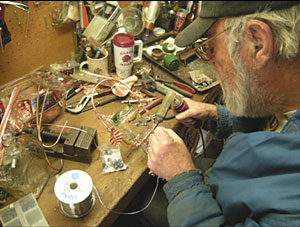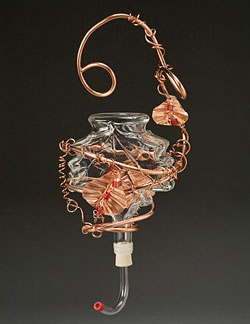Ozarklake Distinct Decor
 Bill Merrit, at work in his studio.
Bill Merrit, at work in his studio. Photograph courtesy of Bill Merrit
During 40 years as a Naval aviation and electronics draftsman, Bill Merritt's experience included manipulating various gauges of wire from thin to tubing sizes. He certainly never considered himself an artist. One day, after his retirement, his wife, Terrie, spied a beautiful glass and copper hummingbird feeder while they were in a store shopping and told him, "You can do this!"
Inspired by his wife's confidence, Merritt collected bottles, vases, gazing balls, decanters and other interesting glass for repurposing into vacuum hummingbird feeders and surrounded them with free-form frames of reclaimed copper wire.
"It wasn't as easy as I thought it would be," recalls Merritt. "My first wire attempts weren't strong enough so I had to experiment with heavier gauges. It was difficult to get the stoppers to fit right, too. I knew if I could get a stopper to work properly, I could make a feeder," Merritt admitted.
Merritt's successful endeavors with copper have grown into a business. His process involves obtaining 30-gauge sheet copper from a supplier in Georgia. Using an ordinary scissors, he cuts out leaves freehand so no two are alike. He then hammers, forms, bends and crimps the copper with a pair of needle-nose pliers. Next, he loops, swirls and twists various gauges of recycled copper wire, usually bought from electronic or construction companies, to the hammered copper before soldering the joints. Strong #4 bare copper ground wire holds up the heaviest glass. When he designs tube hummingbird feeders, he winds the small glass tubes in and out of the copper coils, putting his two-station tube feeders on copper rods for easy placement in hanging baskets, window boxes or large patio plants.
 FInished hummingbird feeder, with reclaimed copper wire.
FInished hummingbird feeder, with reclaimed copper wire. Photograph courtesy of Bill Merrit
Merritt's work has expanded to include Oriole feeders, some made entirely from copper. All contain a copper spike up the middle for attachment of orange slices, grapes or other fruit. He hammers out a copper bowl and adds his decorative twisted vines to create hanging baskets. These can be used as seed feeders for birds or as mud baths to attract butterflies to the garden. Featuring a central portion that is 1/2-inch copper pipe and fittings, his large glass birdbaths sit on a tripod copper base for stability. In response to popular demand, he recently designed sturdy, everlasting all-copper hangers.
"My shepherd's crooks carry my distinct look of copper vines and leaves, accented with glass beads," he says.
Merritt is proud to be a Best of Missouri Hands juried artist, and also received an honorable mention in the mixed media category at a recent art fair in Texas. He creates from his home workshop, where his wife, Terrie, does fine tuning and quality control of their productions and handles the business details. His work will soon be on display from August 20 to 22 at Festival of the Little Hills in St. Charles, Missouri, and at the American Craftsmen exhibition at Silver Dollar City in Branson, Missouri from Sept. 11 to Oct. 30.
Resources:
Also in this Issue:
- Restoring the de Young Museum with Copper
- Ozarklake Distinct Decor
- The Rodin Museum and Garden Landscape Rejuvenation Project
- Native Trails: Elevating the Functional to High Art
- Meet Dave Jones of MADE
